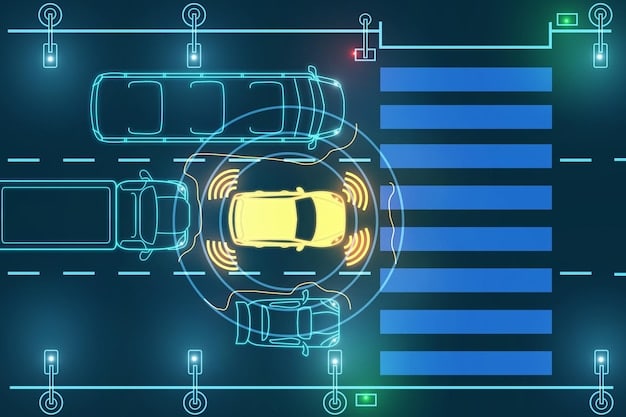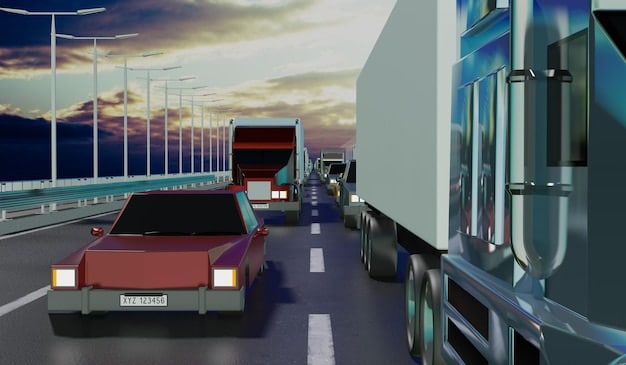Autonomous Vehicles: Revolutionizing US Logistics & Transportation

Autonomous vehicles are poised to transform US logistics and transportation by enhancing efficiency, reducing costs, and improving safety through automated driving technologies.
The landscape of US Transportation: Exploring the Potential of Autonomous Vehicles for Logistics is rapidly evolving, promising significant changes in how goods are moved across the country. This article delves into the potential benefits, challenges, and future possibilities of integrating autonomous vehicles into the US logistics and transportation systems.
Understanding the Basics of Autonomous Vehicles in Logistics
Autonomous vehicles (AVs) are transforming the logistics industry by offering innovative solutions to traditional transportation challenges. Understanding the core principles and technologies behind AVs is essential to grasp their potential impact on US transportation.
Essentially, autonomous vehicles use a combination of sensors, cameras, and sophisticated software algorithms to navigate and operate without human intervention. These technologies allow AVs to perceive their surroundings, make decisions, and execute maneuvers safely and efficiently.
Key Technologies in Autonomous Vehicles
Several essential technologies enable autonomous vehicles to function effectively in logistics operations. These technologies are integrated to provide a comprehensive and reliable self-driving system.
- Sensors: AVs utilize various sensors, including LiDAR (Light Detection and Ranging), radar, and ultrasonic sensors, to gather real-time information about their environment. These sensors detect obstacles, monitor traffic conditions, and maintain safe distances.
- Cameras: High-resolution cameras provide visual data, enabling AVs to identify traffic signals, lane markings, and other road users. Camera systems are often supplemented by computer vision algorithms for object recognition and classification.
- Software and Algorithms: The brain of an autonomous vehicle lies in its software algorithms, which process sensor data, make decisions, and control vehicle movements. These algorithms include path planning, obstacle avoidance, and adaptive cruise control.

The integration of these technologies allows autonomous vehicles to operate with a high degree of precision and safety, making them increasingly viable for logistics applications. Continuous advancements in these areas promise even greater capabilities and efficiency in the future.
In summary, autonomous vehicles represent a significant technological leap that has the potential to revolutionize logistics. By understanding the underlying technologies, businesses can better assess the opportunities and challenges associated with integrating AVs into their operations.
The Potential Benefits of Autonomous Vehicles in US Logistics
Autonomous vehicles offer a wide array of benefits that could significantly improve the efficiency, cost-effectiveness, and safety of logistics operations in the United States. These benefits span various aspects of the transportation industry, presenting a compelling case for the adoption of AV technology.
One of the primary advantages of using autonomous vehicles is the potential to reduce operational costs. By automating driving tasks, companies can minimize labor expenses, which constitute a significant portion of logistics budgets. This can result in considerable savings, especially for long-haul trucking and last-mile delivery services.
Enhanced Efficiency and Productivity
AVs can operate continuously without the need for breaks, allowing for 24/7 operation. This capability can drastically increase the efficiency and productivity of transportation networks, reducing delivery times and improving overall throughput.
- Reduced Downtime: Autonomous vehicles minimize downtime associated with driver fatigue and regulatory breaks, ensuring that goods are transported more efficiently.
- Optimized Routes: AVs use real-time data and advanced algorithms to optimize routes, avoiding traffic congestion and reducing fuel consumption.
- Increased Capacity: Autonomous trucks can potentially travel in platoons, maintaining close distances to reduce wind resistance and improve fuel efficiency, thereby increasing the capacity of existing infrastructure.
In addition to cost savings and enhanced efficiency, autonomous vehicles can also improve road safety. By eliminating human error, which is a leading cause of accidents, AVs can help reduce the number of collisions and injuries on US highways. The integration of advanced safety features and collision avoidance systems further enhances the safety profile of AVs.

In conclusion, the potential benefits of autonomous vehicles in US logistics are substantial. From reducing costs and enhancing efficiency to improving safety, AV technology offers compelling advantages that could transform the transportation industry.
Challenges and Obstacles to AV Adoption in US Transportation
While the potential benefits of autonomous vehicles in US logistics are promising, several challenges and obstacles must be addressed to ensure widespread adoption. These hurdles range from regulatory uncertainties to technological limitations and public perception issues.
One of the most significant challenges is the lack of a clear and consistent regulatory framework for autonomous vehicles. Federal and state regulations regarding the testing, deployment, and operation of AVs are still evolving, creating uncertainty for businesses looking to invest in this technology.
Infrastructure Requirements
The current state of US transportation infrastructure poses another obstacle to the adoption of autonomous vehicles. Many roads and highways lack the necessary markings, signage, and connectivity to support the safe and efficient operation of AVs.
- Road Conditions: Poor road conditions, such as potholes and faded lane markings, can hinder the performance of AV sensors and algorithms.
- Connectivity: Reliable and widespread connectivity is essential for AVs to receive real-time traffic updates, weather information, and other critical data.
- Cybersecurity: Ensuring the cybersecurity of autonomous vehicles is crucial to protect against hacking and other malicious attacks that could compromise vehicle safety and security.
Another obstacle is public perception and acceptance of autonomous vehicles. Many people are hesitant to trust self-driving technology, citing concerns about safety, reliability, and job displacement. Overcoming these concerns requires effective public education and transparent communication about the capabilities and limitations of AVs.
In summary, while autonomous vehicles hold immense potential for transforming US logistics, addressing the challenges related to regulations, infrastructure, and public perception is essential for realizing their full benefits. Overcoming these obstacles will pave the way for the widespread adoption of AV technology and the creation of a more efficient and sustainable transportation system.
The Role of Government and Policy in Promoting AV Logistics
Government and policy play a crucial role in promoting the safe and effective integration of autonomous vehicles into the US logistics industry. Clear and forward-thinking regulations can foster innovation, ensure public safety, and provide a stable framework for businesses to invest in AV technology.
One of the primary responsibilities of government is to establish a comprehensive regulatory framework that addresses key issues such as liability, safety standards, and operational guidelines for autonomous vehicles. This framework should be flexible and adaptable to accommodate the rapid advancements in AV technology.
Investing in Infrastructure and Research
Government investment in infrastructure and research is essential to support the development and deployment of autonomous vehicles. This includes upgrading roads and highways, enhancing connectivity, and funding research into advanced AV technologies.
- Infrastructure Upgrades: Modernizing transportation infrastructure with improved road markings, signage, and sensor technology can enhance the performance and safety of AVs.
- Research Funding: Government funding for research and development can accelerate the development of more advanced and reliable AV technologies.
- Public-Private Partnerships: Collaborations between government agencies and private companies can leverage expertise and resources to promote AV innovation and deployment.
In addition to regulations and investments, government can also play a role in educating the public about autonomous vehicles and addressing concerns about safety and job displacement. Transparent communication and public outreach programs can help build trust and acceptance of AV technology.
In conclusion, government and policy are critical enablers for the successful integration of autonomous vehicles into US logistics. By establishing a clear regulatory framework, investing in infrastructure and research, and educating the public, government can help unlock the full potential of AV technology and create a more efficient, sustainable, and safe transportation system.
Case Studies: Early Adopters of Autonomous Vehicle Logistics
Several companies in the United States have already begun experimenting with and deploying autonomous vehicles in their logistics operations. These early adopters provide valuable insights into the potential benefits and challenges of integrating AV technology into real-world transportation scenarios.
One notable example is a pilot program by a major retailer that uses autonomous trucks to transport goods between distribution centers and stores. This program has demonstrated the potential for AVs to reduce transportation costs, improve delivery times, and enhance overall efficiency.
Success Stories and Lessons Learned
Examining the experiences of early adopters can provide valuable lessons for other companies considering investing in autonomous vehicle logistics. These case studies highlight the importance of careful planning, thorough testing, and collaboration with technology partners.
- Pilot Programs: Conducting pilot programs can help companies assess the feasibility and impact of AV technology in their specific operations.
- Data Analysis: Analyzing data from AV deployments can provide valuable insights into performance, efficiency, and safety.
- Partnerships: Collaborating with technology providers, regulatory agencies, and other stakeholders can help overcome technical and regulatory challenges.
Another example is a delivery company that uses autonomous drones to provide last-mile delivery services in select urban areas. This initiative has shown the potential for drones to reduce delivery times, lower transportation costs, and improve customer satisfaction.
In summary, the case studies of early adopters of autonomous vehicle logistics demonstrate the transformative potential of AV technology. By learning from these experiences, other companies can make informed decisions about investing in and deploying AVs in their own operations.
The Future of Autonomous Vehicles in US Transportation
The future of autonomous vehicles in US transportation is poised for significant growth and transformation. As technology continues to advance and regulatory frameworks become more established, AVs are expected to play an increasingly prominent role in logistics operations across the country.
One of the key trends shaping the future of AVs is the development of more advanced sensor technologies and artificial intelligence algorithms. These advancements will enable AVs to operate more safely and efficiently in a wider range of environments and conditions.
Emerging Trends and Predictions
Several emerging trends and predictions point to a future where autonomous vehicles are an integral part of the US transportation system. These include increased automation, greater connectivity, and the integration of AVs into broader logistics ecosystems.
- Increased Automation: As AV technology matures, we can expect to see greater levels of automation in logistics operations, with AVs handling more complex tasks and navigating more challenging environments.
- Greater Connectivity: Improved connectivity between AVs, infrastructure, and other vehicles will enable more efficient traffic management and coordination.
- Integration into Logistics Ecosystems: AVs will be integrated into broader logistics ecosystems, working seamlessly with warehouses, distribution centers, and other transportation modes.
Another trend is the growing focus on sustainability and environmental responsibility. Autonomous electric vehicles offer the potential to reduce emissions, lower energy consumption, and create a more sustainable transportation system.
In conclusion, the future of autonomous vehicles in US transportation is bright. With continued innovation, supportive regulations, and a growing focus on sustainability, AVs are poised to revolutionize the way goods are moved across the country, creating a more efficient, safe, and environmentally friendly transportation system.
| Key Point | Brief Description |
|---|---|
| 🚚 Efficiency Boost | AVs enable 24/7 operations, reducing downtime and optimizing routes. |
| 💰 Cost Reduction | Automated driving minimizes labor expenses and optimizes fuel consumption. |
| 🚦 Enhanced Safety | AVs reduce accidents by eliminating human error and using advanced safety features. |
| 🌿 Sustainability | Electric AVs can lower emissions, promoting a greener transportation system. |
Frequently Asked Questions
▼
Autonomous vehicles offer enhanced efficiency, reduced labor costs, improved safety, and continuous 24/7 operation, transforming traditional logistics.
▼
AVs use sensors, cameras, and software algorithms to navigate without human intervention, ensuring safe and efficient operation.
▼
Challenges include unclear regulations, inadequate infrastructure, public skepticism, cybersecurity risks, and the need for continuous technological improvements.
▼
The government establishes regulatory frameworks, invests in infrastructure, funds research, and educates the public to promote AV adoption and safety.
▼
Autonomous electric vehicles reduce emissions and lower energy consumption, contributing to a more sustainable transportation system compared to conventional vehicles.
Conclusion
In conclusion, the integration of autonomous vehicles into US logistics presents a transformative opportunity to enhance efficiency, safety, and sustainability. While challenges exist, ongoing technological advancements and supportive policies pave the way for a future where AVs play a crucial role in shaping the transportation landscape.





